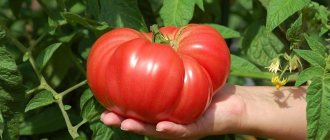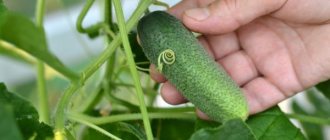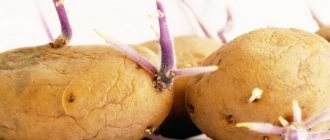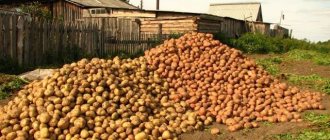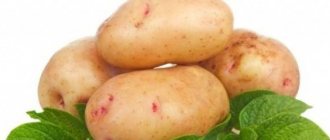For those who think about health, potatoes are essential. The plant, rich in vitamins, amino acids and microelements, treats many diseases. Nutritionists advise focusing on stewed, steamed and baked dishes made from root vegetables, which preserve the gifts of nature.
And recently, experiments have proven that mashed potatoes stabilize brain function and improve memory. The unique property of the plant is due to the presence of glucose. Golubizna potatoes , rich in starch, make ideal dishes.
Description of the variety
Gardeners begin to count the growing season of the mid-late table potato variety Golubizna from the appearance of the first shoots; it lasts from 80 to 100 days. The Golubizna potato variety, included in the State Register of the Russian Federation in the early 90s of the last century, is recommended for cultivation in the Center of Russia, the Volga-Vyatka, and North Caucasus regions. The variety is considered productive - up to 50 tons of tubers can be obtained from 1 hectare. Blueberry potatoes are different:
- high marketability - almost 97% of root crops are stored until spring;
- ability to withstand long-term transportation well.
During the growing season, large tubers weighing from 89 to 120 g are formed; there are also larger root crops, reaching 160 g. One Golubizna potato bush can bear from 9 to 11 fruits. It is estimated that from 1200 to 1400 kg can be removed from each bush. The light skin of the potato is marked with a mesh pattern, which does not affect the taste and healing properties.
The color of the potato pulp is light, does not darken when cut, and does not change color during cooking. There are few eyes on the surface; they are small but deep, which often prevents housewives from peeling potatoes quickly. A distinctive feature of the root crops of the Golubizna variety is their high starch content - from 18 to 20%.
Harvest and storage
Tubers can be dug up no earlier than 3 months after planting. You don’t have to remove the tops before digging; they will dry out on their own by then. The dug up potatoes must be dried outside or in the entryway to remove moisture, then separated from the remaining soil and stored in wooden boxes or bags.
Blueberries are stored at a temperature of 8-10 degrees Celsius in a well-ventilated room without access to light. It is advisable to sort through the potatoes once a month to eliminate the possibility of infection with rot.
Characteristics of Blueberry potatoes
It has been noted that the Golubizna potato variety is appreciated by summer residents, while agricultural technicians like it less. Why summer residents? Potato beds, even planted in the middle of the plot, look quite respectable, without spoiling the landscape with their ordinary appearance.
The bushes of this variety are medium in size, compact tops, large leaves of bright green color, shimmering blue. The flowering period lasts 2 weeks, the plant is covered with light blue inflorescences. These factors gave rise to the unusual name.
In order for the harvest to please you with quantity and quality, you need to study the plant’s habits and know its preferences. Start with the soil. Golubizna potatoes grow well on loam and sandy soil.
Text of the scientific work on the topic “New potato variety Golubka”
Agricultural Science of the Euro-North-East, No. 4 (41), 2014 UDC 633.491:631.523
New potato variety Golubka
Zoya Fedorovna Sergeeva, candidate of agricultural sciences sciences, head laboratory, Nina Fedorovna Sintsova, candidate of agricultural sciences. Sciences, Art. Researcher, Irina Vladimirovna Lyskova, Candidate of Agricultural Sciences Sciences, Art. Researcher, State Scientific Institution Falenskaya Breeding Station, Research Institute of Agriculture of the North-East, Falenki village, Kirov region, Russia
The article presents the characteristics of a new mid-early potato variety Golubka (Aralia x 282-97), which combines high yield (up to 43.5 t/ha) with resistance to viruses, the common cancer pathotype, golden potato nematode, and common scab. The tubers of the new potato variety are suitable for industrial processing, have a round-oval shape, superficial eyes, dry matter content of 21.7-23.5%, protein up to 2.9%, starch 13.9-15.9%. Taste quality 3.6-4.0 points, the pulp of the boiled tuber is white and crumbly. The variety is suitable for growing in all types of soil. Based on the results of environmental testing in 2012-2013. The Golubka variety exceeded the Nevsky standard in yield by an average of 1.2. 3.9 t/ha. In 2013, the Golubka variety was submitted for state variety testing.
Key words: potato, variety, yield, disease resistance, dry matter content
In terms of gross potato production, Russia ranks second among the largest producers in the world - 29-31 million tons annually [1]. At the same time, in terms of average yield (less than 14 t/ha), Russia lags significantly behind the world level (17 t/ha). The main requirements imposed by agricultural producers on newly created varieties are high and stable yields, adaptability to soil and climatic conditions of cultivation, and high quality products. One of the main reserves for stabilizing and increasing potato productivity in the Volga-Vyatka region is the development of varieties adapted to local conditions, and overall environmental sustainability is closely related to the quality of the crop (chemical composition, taste, marketability) and resistance to biotic factors [2] . The accumulation of crops in the Volga-Vyatka region is limited by severe weather conditions: a short frost-free period, often dry weather in the spring-summer months, uneven distribution of precipitation during the growing season, etc. In addition, the soil and climatic conditions of most areas of the zone show the need to create varieties of predominantly early and mid-early ripening [3].
The goal of the research is to create a potato variety that combines high yield with resistance to diseases and pests, with good marketing and taste properties, adapted to the conditions of the European Union.
Material and methods. The research was carried out in the laboratory of selection and primary seed production of potatoes of the State Institution Falenskaya Breeding Station of the Research Institute of Agriculture of the North-East of the Russian Agricultural Academy in accordance with the “Guidelines for potato breeding technology” [4] and “Methodology for potato culture” [5]. The genetic sources of Aralia (Poland) and the hybrid of the Falen breeding station 282-97, which were isolated during study in local conditions for biological and economically valuable traits, were used as parent forms to create a new potato variety. Both samples are medium early with good taste. Aralia has a smooth tuber with superficial eyes that is moderately resistant to viral diseases. The advantages of hybrid 282-97 are high yield (35.5 - 40.7 t/ha), resistance to potato nematode, cancer, and viral diseases.
Article on the topic: Potato variety “Giant” - description and photo
Results and its discussion. The potato variety Golubka, breeding number 428-05, was created by artificial hybridization Aralia x 282-97 followed by clonal selection. Hybridization was carried out in 2002. Clone - selection number 428-05 was selected from the F2 hybrid population in 2005. In 2006-2008. number 428-05 was studied in breeding nurseries in 2009-2013. - in competitive variety testing. In 2013, selection number 428-05 was transferred to the state
genetic variety testing as a potato variety Golubka.
Morphological characteristics of the potato variety Golubka. The bush is low, semi-spreading, 5-6-stemmed. The stem is medium thick, cranked, rounded, slightly colored in the lower part, in the upper part - in the axils of the leaves. The wings of the stem are straight, narrow, and green in color. The leaf is large, dark green, medium-dissected. The leaflet is large, wide, obovate, weak ivy, slightly wavy edges. Flowering is abundant. Inflorescence of medium size, multi-flowered. The corolla of the flower is medium, red-violet in color with white tips. Fertile. Berry formation is very good. The tubers are oval in shape, the skin color is white, smooth, eye-
Productivity of potato variety Golubka, t/ha
The ki are superficial, uncolored, the flesh is white, does not darken when cut.
On average, over the years of competitive variety testing, the yield of the new Golubka potato variety was 34.5 t/ha, the Nevsky standard - 31.5 t/ha, the Gloria variety previously transferred to state testing - 33.4 t/ha, the increase was respectively 3. 0 and 1.9 t/ha (Table 1). The maximum yield (43.5 t/ha) was obtained in the most favorable year of 2009. Under drought conditions in 2010, the Golubka variety significantly exceeded the standard by 3.1 t/ha with a yield of 23.0 t/ha. Based on the results of environmental testing in 2012-2013. the new variety surpassed the Nevsky standard in yield by an average of 1.2...3.9 t/ha at the Research Institute of Agriculture of the Komi Republic and the Perm Research Institute of Agriculture.
Competitive test Environmental test, 2012-2013
Variety 2009-2013 deviation from the standard of the Research Institute of Agriculture of the Komi Republic Perm Research Institute of Agriculture
Golubka 34.5 +3.0 21.8 25.4
Nevsky, standard 31.5 - 20.6 21.5
The Golubka potato belongs to the group of mid-early ripening varieties. During trial digging on the 60th day after planting, the yield of the new variety (11.1 t/ha) was higher than the standard varieties Nevsky and Gloria by 0.8 t/ha. The variety is characterized by stable productivity over the years, early tuber formation and rapid accumulation of yield in the first half of the growing season. Golubka produces the highest yields in years with sufficient moisture. A high marketable yield is ensured by the number of tubers in the nest (Table 2). The variety produces from 11 to 15 tubers per bush with an average weight of one marketable tuber of 70-120 g.
The new variety has good table quality and keeping quality with a long physiological dormant period for the tubers. The taste rating is 3.6-4.0 points, the pulp of the boiled tuber is white and crumbly. According to morphological and biochemical indicators, the tubers are suitable for industrial processing: round-oval shape, superficial eyes, co-
dry matter content 21.7-23.5%, protein up to 2.9%, starch 13.9-15.9%.
For all the years of observation, no symptoms of common scab were noted on the tubers of the Golubka variety, while the standard Nevsky variety was affected by 11-46%. The Gloria variety is resistant to the usual cancer pathotype and the golden potato cyst nematode, is moderately susceptible to late blight of tubers and leaves, and has field virus resistance (Table 3).
The Golubka variety is responsive to the application of increased doses of mineral fertilizers and is suitable for cultivation on all types of soil. To obtain quick and uniform germination, it is recommended to germinate or heat the tubers before planting; when grown for seed purposes, dense planting of 70.80 thousand pieces/ha and mowing of the tops at optimally early dates.
Recommended cultivation zones for the new potato variety Golubka: Northern, Volga-Vyatka and Middle Volga regions of the Russian Federation.
Main economically valuable traits of the Golubka variety (2009-2013)
Varieties Total number of tubers, pcs./bush Number of marketable tubers, pcs./bush Average weight of marketable tuber, g Marketability of tubers, % Starch content, % Dry matter, %
Golubka 11-15 6-10 70-120 86-96 13.9-15.9 22.6
Nevsky, standard 9-12 6-9 78-112 88-96 12.2-14.2 20.2
Gloria 8-10 5-8 70-98 93-98 11.8-15.4 22.9
Phytopathological characteristics of the Golubka variety (2009-2013)
Varieties Resistance to Resistance to late blight, score Damage to viral diseases Damage to common scab, %
potato nematode cancer of tuber leaves during artificial infection in the field, serological analysis score, %
in the field with artificial infestation
Dove mouth mouth 3 1.0 4.9 5 19-26 0-0
Nevsky, standard oral reproduction 8 5.2 4.7 3 42-96 11.0-46.0
Gloria mouth mouth 5 3.7 4.7 5 25-56 2.7-8.1
Note: mouth - stable, reproduce - receptive
Conclusions. A new potato variety, Golubka, was created and submitted for state variety testing in 2013. It is a universal potato variety that combines high yield (up to 43.5 t/ha) with good taste and commercial qualities, resistant to cancer, golden potato nematode, common scab, and viral infections. diseases.
1. Simakov E.A. Modern trends and prospects for innovative development of potato growing // Modern trends and prospects for innovative development of potato growing: Materials of scientific and practical research. conference Cheboksary: Municipal Unitary Enterprise of the Chuvash Republic “Agro-Innovations”, 2011. pp. 6-9.
2. Zhuchenko A.A. Biological-genetic
fundamentals of biologization and ecologization processes in plant growing // Potato growing: collection of scientific papers, materials of the scientific conference “World genetic resources of potatoes and their use in modern breeding directions” for the 125th anniversary of the birth of N.I. Vavilova. M., 2012. P. 8-36
Article on the topic: Potato variety “Vershininsky” - description and photo
3. Sintsova N.F., Sergeeva N.F. Selection of potatoes for early ripening in the North-East of Russia // Potato growing in Russia: current problems of science and practice: Materials of the International Congress “Potato. Russia-2007". M.: FGU "Rosinformag-rotech", 2007. P. 87-91.
4. Guidelines for potato breeding technology. M.: VNIIKH, 1994. 22 p.
5. Methodology for potato culture. M.: VNIIKH, 1967. 264 p.
New potato variety Golubka Serqeeva Z., Sintsova N., Lyskova I.
Characteristics of mid-early potato variety Golubka (Aralia x 282-97) which combines high productivity (up to 43.5 t/ha) with resistance to viruses, common pathotype of cancer, golden potato nematode, common scab is presented in the article. Tubers of new potato variety are suitable for industrial processing; they are orbicular-oval shape, surface eyes; the dry matter content of 21.7-23.5%, of protein up to 2.9%, the average content of starch 13.9 to 15.9%. Taste qualities are 3.6-4.0 points; pulp of cooked tuber is white loose. The variety is suitable for cultivation in all types of soils. By results of ecological testing in 2012-2013 the variety Golubka exceeded the standard Nevsky on yield on average by 1.2. 3.9 t/ha. In 2013 variety Golubka is passed to the State variety trial.
Key words: potato, variety, productivity, disease resistance, dry matter content
Preservation of the common hop collection (Humulus lupulus L.) and identification of sources for the formation of a working genetic collection
Andrey Anatolyevich Fadeev, candidate of agricultural sciences Sciences, Director, Zoya Aleksandrovna Nikonova, Researcher, Yulia Sergeevna Osipova, Jr. Researcher,
State Scientific Institution Chuvash Research Institute of Agriculture, Opytny village, Tsivilsky district, Chuvash Republic, Russia
At the State Scientific Institution Chuvash Research Institute of Agriculture, 247 domestic and foreign varieties of common hop (Humulus lupulus L.) are preserved and studied in order to select valuable source material based on economically important traits for the formation of a working genetic collection. The sources identified were 26 early-ripening, 30 mid-early, 78 mid-ripening, 44 mid-late, 69 late-ripening, 97 frost-resistant, 44 high-yielding, 73 aromatic, 44 bitter, 27 varieties that combine a number of economically valuable traits. 170 sources of resistance to downy mildew with a degree of damage from 0 to 1 point, and to root rot - 150 varieties of domestic and foreign origin were identified. The selected sources can be used as female plants in breeding work to create new varieties of aromatic and bittering hops.
Key words: collection, variety sample, growing season, ripeness group, technical ripeness, weight of raw buds, alpha acid content, downy mildew, root rot
Plant genetic resources serve as a strategic basis for effective sustainable development of agriculture.
In Russia and in hop-producing countries, work is underway to collect, preserve, study and form a collection of world
Features of planting, care
It is recommended to start planting Golubizna potatoes in the first half of May. Experienced gardeners know that the basis for planting is not only the calendar period, but also the soil temperature. If the earth has not yet warmed up to 7 degrees, you should wait. But if the planting period is delayed, you won’t have to count on keeping quality. It's not all trouble. The starch content will decrease, and this will affect the taste.
The principle of planting Blueberry potatoes depends on the climatic conditions of the region. If the climate is close to arid, it is necessary to use flat areas, planting in rows. High humidity requires a different approach. In this case, agricultural technicians advise choosing “ridges”. The distance between rows should be maintained at least 70 cm. If the humidity is considered high, it is increased by 20 cm.
The depth of planting potatoes is dictated by 3 factors: its method, climate and the quality of root crops. Ridge planting requires putting the tubers 7-8 cm into the ground. The same depth is recommended for loam. Sandy soil allows it to go deeper than 5-6 cm.
Agrotechnicians remind you that Golubizna potatoes, although not particularly picky, require fertilizing, which is applied to each hole during planting. It includes:
- 1 tbsp. l. bird droppings powder;
- 1 cup of overripe manure (can be replaced with compost);
- wood ash (half a glass);
- earth (1 cup).
The mixed composition is added to the ground and sprinkled on top with a 2 cm layer. Root crops should be planted with their sprouts facing up. During the growth period, Golubizna potatoes need to be fertilized with organic types of fertilizers. Among them:
- bird droppings powder;
- infusion of stinging nettle;
- infusion of mullein herb.
Breeders who know the needs of this variety advise using potassium, phosphate, and nitrogen fertilizers separately, taking into account the development phases.
The word “watering” in the situation with the Golubizna variety loses its relevance. Potatoes easily tolerate a lack of moisture.
Growing seeds
There is no point in talking about how to plant Blue potatoes. It is not demanding in care, grows on any type of soil and is not particularly capricious in terms of fertilizers. And in general, every self-respecting gardener has already properly studied the art of growing root vegetables.
But it’s worth talking about how to grow seedlings from seeds. The thing is that the main disadvantage of this variety is degeneracy.
Blueberry produces the best harvest in the first 4 years of planting. Further, the variety acquires a lot of diseases, and, as a rule, the yield drops unnaturally. To prevent this from happening, planting material is changed every 3 years.
You can go the simple route and buy it on the market (although finding seeds of this variety is quite difficult). But if you want to save money, or gardening is a human hobby, then you can safely start growing your own seedlings.
The sequential scheme for growing potatoes from seeds looks like this:
- First of all, they pick the berries from the bushes and leave them to rest. This is necessary so that they are fully ripe. After ripening, the seeds are removed from the berries, washed and dried.
- The second stage is preparation. Plant seeds in late March or early April. Before planting, planting material is soaked in water for 7-14 days. Soak the seeds in a cloth. By wrapping them in it, you can easily control the humidity.
- The third stage is landing. By the time the seeds are planted, they should already have slightly sprouted. The hatched seeds are placed in boxes or pots with well-fertilized soil. Until the first shoots appear, the boxes are kept in the greenhouse, only occasionally opening it for ventilation.
- 14 days after the mass appearance of sprouts, the potatoes are cropped in peat pots. After this, carefully care for the seedlings. Water it with warm water and remove any weeds that appear.
- Already at the end of May, or earlier, depending on the weather, seedlings can begin to be planted in the garden.
The main problem when growing potatoes from seeds can be their capriciousness. Growing potato seedlings is quite difficult. Causes problems:
- Severe dependence on sunlight. In a dark place, seeds will not grow, and if they do, they will grow into rather frail and low-yielding bushes.
- Weak immunity. Very often, when grown from seeds, potatoes are affected by blackleg.
- The fragility of escape. One careless movement and the bush is broken.
Productivity
The productivity of vegetable crops is related to climatic conditions and care regime. Blueberry potatoes are no exception. The agricultural technology of the Golubizna variety is the same as that of its fellow tribesmen.
What experienced gardeners advise you to pay attention to is planting and care. It is important not to forget to weed and hill up potato bushes in a timely manner. Potatoes of the Golubizna variety are hilled twice. The first time - after the emergence of seedlings, the second time, when the plants rise above the ground to a height of 20 cm. Although potatoes are indifferent to moisture, watering will not hurt in dry summers.
Preparations for harvest begin at the end of August. The “beacon” for starting harvesting is the tops. As soon as it dries and falls to the ground, it is mowed. And after 2 weeks they begin to dig up potatoes. Before storing the Golubizna variety for winter storage, the tubers need to be dried. Root vegetables are stored at a temperature of +2+4 degrees.
The main advantages and disadvantages of the variety
According to reviews from gardeners about Golubizna potatoes, the positive aspects of the variety are highlighted:
- high productivity;
- storage duration;
- marketability and portability of transportation;
- same sizes;
- resistance to diseases and drought;
- beautiful bushes.
Everyone has shortcomings, although Blueness considers them minor and not so important:
- the large size of the tubers complicates the search for tubers during harvesting;
- In severe drought, potatoes may lose their beautiful round shape and become deformed.
Potato tubers are too large for industrial scale, and therefore are not very popular among farmers.
Pests, diseases
Potatoes of the Golubizna variety are distinguished by their strong immunity to diseases typical of their potato counterparts. Rots, nematodes, mosaic viruses, scab, and cancer are not scary for these root crops.
The same cannot be said about a rainy summer, which in the case of Blue potatoes poses a serious threat. In such a climate there is a danger of late blight. What to do if this happens? First aid, and at the same time treatment, will be spraying the plants 3 to 4 times. We buy:
- Bordeaux mixture (1%);
- copper sulfate (100 g);
- lime (150 g);
- drug "Hom" (50 g).
All preparations are mixed with water at the rate of 10 liters. Pests are much more difficult. The Colorado potato beetle or mole cricket can destroy the crop. Insects in tandem are especially dangerous: the mole cricket eats up root crops, leaving holes in them, and the Colorado potato beetle eats the tops.
As for Colorado potato beetles, they can be seen on potato leaves. With the bear the situation is worse. It is difficult to understand what is happening underground. Stock up on Medvetox. One granule of the drug is used for one unit of insect.
Be careful when planting Blueberry potatoes. As you work, don't forget to watch the soil. If you come across at least one mole cricket, it is possible that there will be many of them as they grow.
Colorado beetles are easier to deal with. The arsenal of remedies, including folk recipes, ready to join the fight, is quite wide. But it is worth remembering that it is not recommended to use the same substance for 2 years in a row - the enemy, although petty, is vindictive. As a rule, in agricultural technology the insecticides “Dilorom”, “Komandorm”, “Confidor”, “Colorado”, “Iskra” are used, with which the above-ground part is sprayed.
Nuances of cultivation
As noted above, Golubizna is suitable for growing in any type of soil and is not afraid of climatic changes.
Even if there is intense heat, Blueberry will still please you with the harvest. But this does not mean that potatoes do not need to be looked after.
We recommend reading: “Riviera Potatoes”
Regarding landing, everything is standard here:
- It is best to plant root crops in early or mid-May, depending on your region of residence. Planting is carried out in heated soil when the ambient temperature has reached +9 C.
- If your planting material is large, then it would be logical to divide it. Unlike other varieties, Golubizna survives this division quite painlessly.
- Planting is carried out according to the standard pattern - 30 cm between holes and 70 cm between rows.
Agricultural work is also standard. After the tops have grown by 20-25 cm, the first hilling is carried out. The second hilling is carried out after 15-20 days.
Watering is also included in the mandatory care procedure. However, after the potatoes have flowered, irrigation is stopped.
Reviews
«We consider Golubizna potatoes to be the most delicious. What is attractive about this variety is its unpretentiousness in care - frequent watering is not needed, and its resistance to temperature changes. Cold snaps are not uncommon in our area. And we learned to cope with the Colorado potato beetle,” Marina Ryzhova, Bezhetsk.
“It is no coincidence that breeders call Golubizna potatoes one of the best among domestic varieties. It really does not create any inconvenience for the owners. Of course, we go down to the basement to check the tubers and sort them out. It is worth noting: root vegetables are stored well. We fry potatoes, boil them, bake them, make pancakes. Delicious!” - Kurenkov family, Nizhny Novgorod.
“In our SNT, almost every owner has one or two beds of Golubizna potatoes. It is necessary to have this variety on the site. It is necessary to maintain the continuation of the species, because it is not only tasty, but they say it is also healthy. Sharing my experience, I want to emphasize that you need to prepare for planting in the fall. This is the best time to apply fertilizers,” Nikolay Bochkarev, Engels.
“My wife and I are not young people, so we try to keep only those plants on the plot that do not require endless work. I advise everyone to pay attention to potatoes called Golubizna. Plant it, you won't regret it. It is both tasty and healing. Before planting, cut the tubers in half. It’s growing by leaps and bounds.” Peter and Maria Ivanov, Voronezh region.
How to properly care for the variety
Fertilizing alone during planting will obviously not be enough for the entire season, which means that not only watering and weeding will be required, but also the application of fertilizers, as well as preventive spraying against diseases. If pests appear, it will be necessary to use special means to destroy them.
Potato plantation requires fertilizing
Features of watering
Since the Golubizna variety is not demanding when it comes to watering, its regularity does not play a big role. During drought, it is better to increase the amount of water, and in normal weather three times during the growing season is enough.
Note! With a lack of moisture, the potatoes go deeper, which means digging up the tubers will be more difficult; they will be quite deep.
Feeding and fertilizing
The first time fertilizer is applied before planting, then ash is added. The next feeding period comes during the growing season; the best means would be bird or cow manure, as well as complex fertilizers with mineral components.

